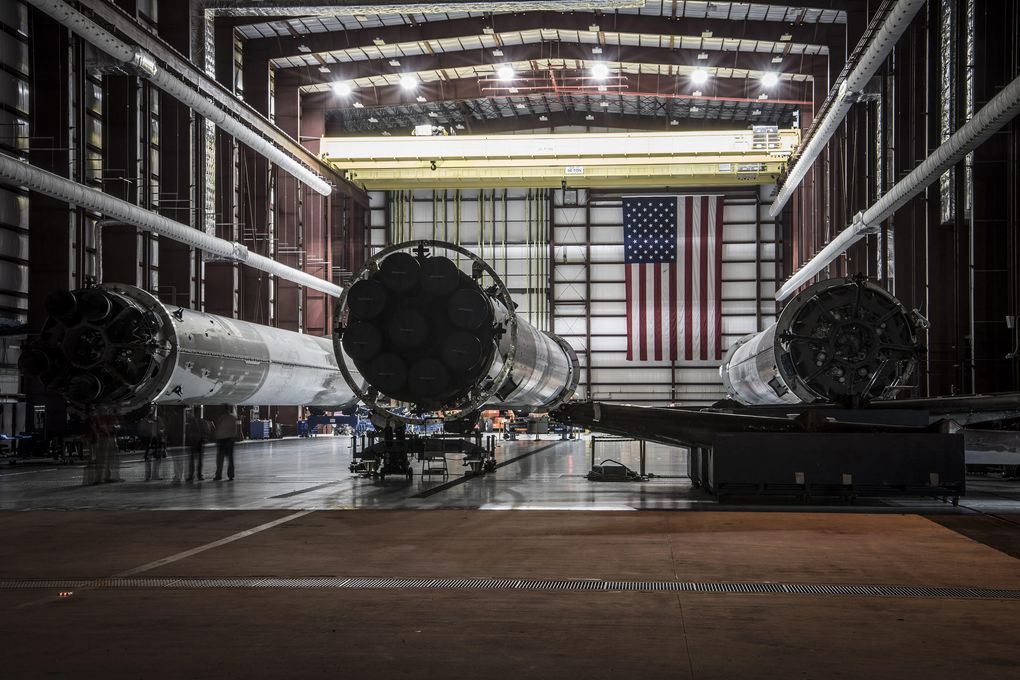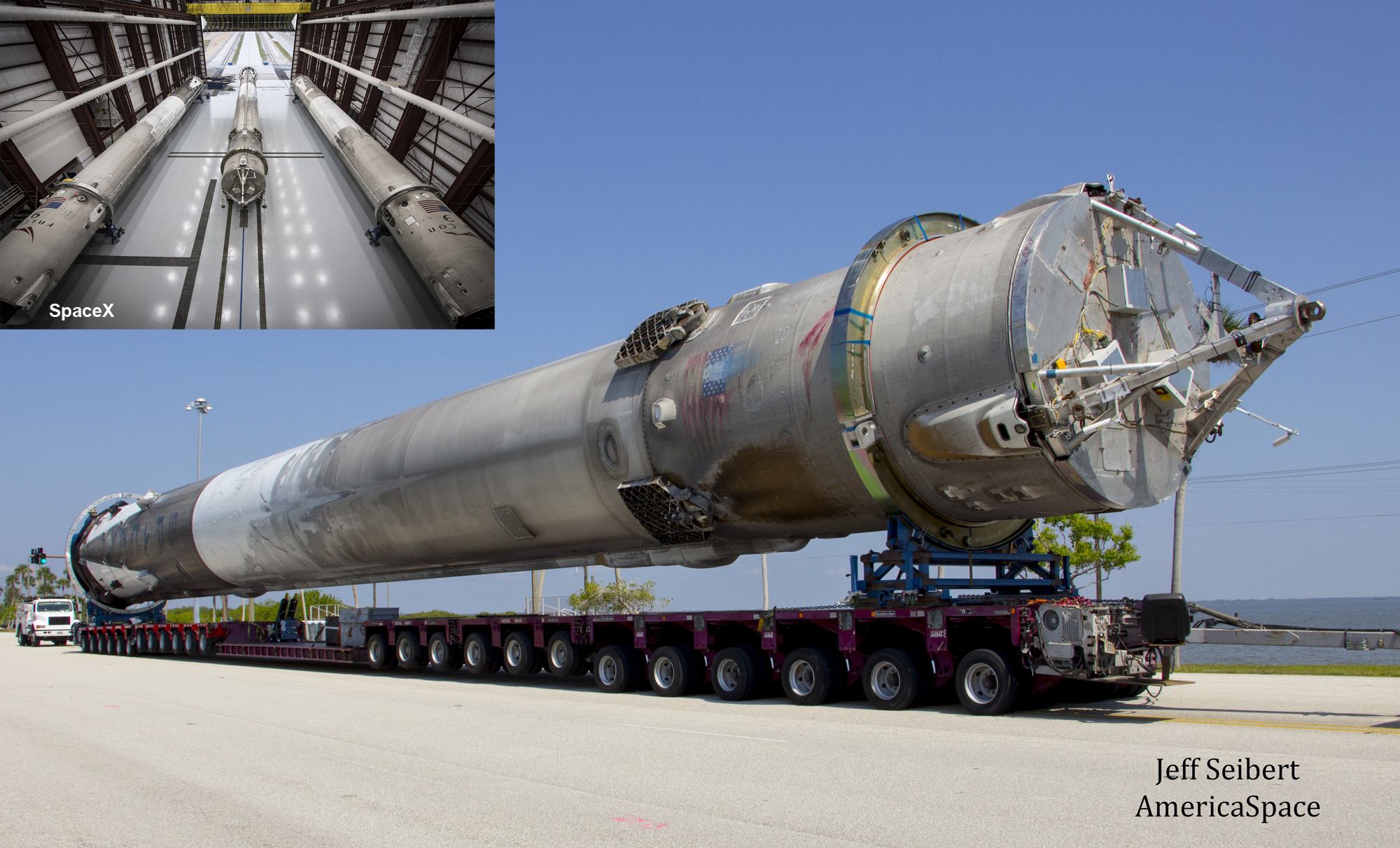Ilon Musk: the stage of the Falcon 9 rocket that has returned to Earth will be re-launched this fall
SpaceX once again showed the hangar, where the four first steps already returned are stored.

Today, the permanent head of SpaceX, Ilon Mask, announced his intention to launch Falcon 9 from one of the first steps that had returned to space this fall. Most likely, writes Musk, the launch will be made in September or October. This will be the first re-launch of the Falcon 9 stage, and in the fall it will become clear whether the SpaceX program to return the spent rocket stages is realizable.
')
In April of this year, Ilon Mask announced that the re-start of the stage will be carried out already in May or June of this year. It was a rather ambitious goal, which was to prove to skeptics the correctness of a company seeking to debug a missile launch cycle with the return of a spent first stage. In this case, it is not about 1-2 re-launches of the returning part of the rocket, but about tens or even hundreds of cycles. Without replacing parts of the step, the number of start-up cycles can reach 20, provided that minor updates are made, this figure will increase to hundreds of starts. Unfortunately, for several reasons, the “experiment” with the re-launch of the rocket stage has been postponed.
Musk says that the re-flight of a spacecraft with the return of the first stage will be regular, although it will be an experiment. But the company will not launch a rocket idling - the satellite will also fly into space with it. The cost of launching a rocket using the first stage will be $ 43 million, not $ 61 million, as it is now.
In the third and fourth quarter of this year, the company is going to launch Falcon 9 once every two weeks, maybe a little less.

Last month, SpaceX showed the insides of a hangar where the spent steps are stored. The hangar is located on Launch Complex 39A, the spaceport at Cape Canaveral, Florida, USA. The company rents a launch complex from NASA. In a huge hangar 39A can simultaneously be stored up to 5 objects equal in size to the first stage of the Falcon 9 rocket. Now there are already four stages in the hangar.
At the same time, the first returned stage will not be launched anywhere - this is an object for study and a peculiar exhibit in the history of astronautics. A step that returned in May cannot be used to restart either. Step suffered too much damage . True, Musk says that it is useful for studying the characteristics of the take-off and landing of rockets. The stage can be used for comparative diagnostics of other returned missiles. In general, nothing good was expected from the May landing, since the rocket was supposed to deliver a JCSAT 14 communication satellite with a mass of 5 tons to a geostationary orbit. Due to the fact that the rocket had to fly higher than in any of the previous launches, there was much less fuel for landing than ever before. Due to all these overloads, it received significant damage, plus the rate of entry into the Earth’s atmosphere was also quite high.

So they will launch some of the two remaining steps (remember, there are four of them in the hangar). After working off the cycle “launch of a rocket-return stage — re-launch”, the time to complete this cycle will be reduced to several weeks. If this could be implemented in practice, the launch cost should be significantly reduced. The biggest budget item for launch is the rocket. Disposable rocket is very expensive. Imagine how much a car would cost if after each trip it had to be thrown away. At the same time, fuel costs relatively little - it takes a fraction of a percent of the launch budget.
Well, knowing Mask, you can think that everything will work out in the fall. And then launches will really become cheaper, and space will become at least a little bit, but closer to us, figuratively speaking.

Today, the permanent head of SpaceX, Ilon Mask, announced his intention to launch Falcon 9 from one of the first steps that had returned to space this fall. Most likely, writes Musk, the launch will be made in September or October. This will be the first re-launch of the Falcon 9 stage, and in the fall it will become clear whether the SpaceX program to return the spent rocket stages is realizable.
')
In April of this year, Ilon Mask announced that the re-start of the stage will be carried out already in May or June of this year. It was a rather ambitious goal, which was to prove to skeptics the correctness of a company seeking to debug a missile launch cycle with the return of a spent first stage. In this case, it is not about 1-2 re-launches of the returning part of the rocket, but about tens or even hundreds of cycles. Without replacing parts of the step, the number of start-up cycles can reach 20, provided that minor updates are made, this figure will increase to hundreds of starts. Unfortunately, for several reasons, the “experiment” with the re-launch of the rocket stage has been postponed.
Musk says that the re-flight of a spacecraft with the return of the first stage will be regular, although it will be an experiment. But the company will not launch a rocket idling - the satellite will also fly into space with it. The cost of launching a rocket using the first stage will be $ 43 million, not $ 61 million, as it is now.
In the third and fourth quarter of this year, the company is going to launch Falcon 9 once every two weeks, maybe a little less.

Last month, SpaceX showed the insides of a hangar where the spent steps are stored. The hangar is located on Launch Complex 39A, the spaceport at Cape Canaveral, Florida, USA. The company rents a launch complex from NASA. In a huge hangar 39A can simultaneously be stored up to 5 objects equal in size to the first stage of the Falcon 9 rocket. Now there are already four stages in the hangar.
Fourth rocket arrives in the hangar. Aiming for first reflight in Sept / Oct. pic.twitter.com/TqW8d6Cc3U
- Elon Musk (@elonmusk) June 7, 2016
At the same time, the first returned stage will not be launched anywhere - this is an object for study and a peculiar exhibit in the history of astronautics. A step that returned in May cannot be used to restart either. Step suffered too much damage . True, Musk says that it is useful for studying the characteristics of the take-off and landing of rockets. The stage can be used for comparative diagnostics of other returned missiles. In general, nothing good was expected from the May landing, since the rocket was supposed to deliver a JCSAT 14 communication satellite with a mass of 5 tons to a geostationary orbit. Due to the fact that the rocket had to fly higher than in any of the previous launches, there was much less fuel for landing than ever before. Due to all these overloads, it received significant damage, plus the rate of entry into the Earth’s atmosphere was also quite high.

So they will launch some of the two remaining steps (remember, there are four of them in the hangar). After working off the cycle “launch of a rocket-return stage — re-launch”, the time to complete this cycle will be reduced to several weeks. If this could be implemented in practice, the launch cost should be significantly reduced. The biggest budget item for launch is the rocket. Disposable rocket is very expensive. Imagine how much a car would cost if after each trip it had to be thrown away. At the same time, fuel costs relatively little - it takes a fraction of a percent of the launch budget.
Well, knowing Mask, you can think that everything will work out in the fall. And then launches will really become cheaper, and space will become at least a little bit, but closer to us, figuratively speaking.
Source: https://habr.com/ru/post/394811/
All Articles